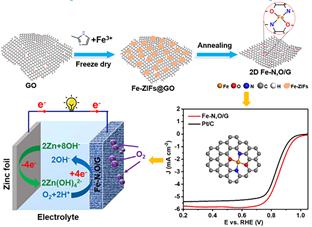Zn-air batteries have drawn considerable interests owing to high theoretical energy density (1086 Wh kg-1) and safety among various metal batteries. However, the scarcity of precious metals and the poor activity of alternative electrocatalysts in the air-cathode hinder the commercialization of Zn-air batteries.
The Fe-N coordinated single atom catalysts (SACs) are regarded as one of the most promising alternatives to commercial Pt/C catalyst for oxygen reduction reaction (ORR) in Zn-air batteries. Nevertheless, precise regulation of the coordination configuration of Fe single atom to enhance catalytic performance remains elusive.
Recently, research groups led by Prof. BAO Xinhe and Prof. WU Zhong-Shuai, respectively, from the Skate Key Laboratory of Catalysis, Dalian Institute of Chemical Physics (DICP) of the Chinese Academy of Sciences (CAS) demonstrated an innovative configuration of N,O symmetric double-coordinated Fe single atoms on graphene framework (Fe-N,O/G) for highly active and durable ORR catalyst in Zn-air batteries by regulating the coordination environment with the coordinatively unsaturated (CUS) Fe sites.
This study was published in Energy Environmental Science on May 4.

Image by schematic diagram of synthetic Fe-N,O/G and the Fe-N,O/G-based Zn-air battery, and ORR performance of Fe-N,O/G and Pt/C
The researchers indicated that the as-designed Fe-N,O/G catalyst exhibited an half-wave potential of 0.86 V, excellent stability, and methanol tolerance. Further, the fabricated Zn-air battery afforded a large peak discharge power density of 164.7 mW cm-2 and an outstanding discharge stability of >150 h at 20 mA cm-2, outperforming commercial Pt/C catalyst.
Theoretical calculation results prove that the configuration of N,O symmetric double coordination can effectively adjust the electronic structure of Fe single atom and the adsorption strength of the active site towards the intermediate, thereby resulting in improved catalytic performance.
“This work offers a new idea for designing and tuning the precise coordination environment of metal single atoms to realize optimal catalysts in metal-air batteries,” said Prof. WU.
The above work was supported by the National Natural Science Foundation of China, and Dalian National Laboratory for Clean Energy of CAS. (Text by LI Yuejiao)
Key words: Fe Single atom, graphene framework, symmetric coordination, oxygen reduction, Zn-air battery
Website: https://pubs.rsc.org/en/content/articlelanding/2023/ee/d3ee00747b